Credits & Sources |
 |
This exhibit was underwritten by grants from the National Endowment for the Humanities and the Texas Preservation Trust Fund ( Texas Historical Commission). Additional support was provided by the Summerfield G. Roberts Foundation, the Clements Foundation, and the College of Liberal Arts (UT Austin) as well as the Texas Archeological Society and the Council of Texas Archeologists. The creation of the Hinds Cave exhibit was truly a collaborative effort. Harry Shafer, TBH editor Steve Black, and Vaughn Bryant are the primary authors. In addition, Glenna Dean, Phil Dering, Ken Lord, and Joe Saunders contributed to the creation of the exhibit by providing access to their published studies and unpublished notes as well as photographs, memories, and critical review. All four deserve credit as co-authors. The “Natural Setting” section borrowed heavily from Dean 1978, the excavation descriptions by Lord 1974 and Saunders 1986 are used in the “Explore Hinds Archeology” section, Dering’s words appear in the “Paleoclimate” and "Life at Hinds" sections. At Texas A&M University, Curator of Anthropology Patricia Clabaugh helped out in many ways. She and her staff provided access to the Hinds archives and scanned many field records and field photographs that appear in this exhibit. Most importantly they took hundreds of digital photographs of the Hinds Cave materials. Under Clabaugh’s supervision, assistant P. L. Wood did the artifact photography and was responsible for all of the photos with turquoise background. At TARL, TBH editorial assistants Erin Tyson and Jeff Taff helped create the exhibit. Tyson was responsible for scanning photographs and documents and preparing these for web publication. Tyson and TBH web designer Meg Kemp are jointly responsible for the layout and appearance of the web exhibit. Jeff Taff compiled a database of all Hinds Cave radiocarbon dates and used this to create several of the graphics that appear in the exhibit. The "Detectives into the Past" activity for kids is the brainchild of TBH co-editor Susan Dial. She and TBH education editor Carol Schlenk developed this activity. Carol also created the "Comparing Two Cultures" lesson plan for teachers. Special thanks to the Witte Museum of San Antonio for allowing the use of many of the drawings and paintings by George Strickland that appear in the 1986 book Ancient Texans: Rock Art and Lifeways along the Lower Pecos, published by the Witte Museum and Texas Monthly Press. Rebecca Huffstutler at the Witte kindly scanned the original artwork. Visitors to the Witte can see several Hinds Cave artifacts on display as well as related materials from the dry caves of the Lower Pecos. Artist Peggy Maceo painted the “Life in a Rockshelter” scene based on evidene from Hinds Cave. Research CreditsThe Hinds Cave investigations were carried out by the Department of Anthropology at Texas A&M University, a partner in the Texas Beyond History website. The Hinds Cave expedition was planned as an interdisciplinary project that involved both archeology and botany. The archeologist that led the Hinds Cave expedition was Harry J. Shafer and the botanist was Vaughn M. Bryant, Jr.; both are anthropologists and professors of anthropology at Texas A&M University. 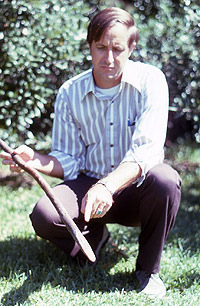
Harry Shafer holding a digging stick found at Hinds Cave. Photo taken in 1974. TAMU Anthropology archives.
Harry Shafer is a native Texan who received his B.A. and PhD degrees from The University of Texas at Austin. He worked for a decade doing reservoir salvage archeology at the Texas Archeological Salvage Project in Austin before becoming the first archeologist on the faculty at Texas A&M University. He taught there for 30 years. His research has taken him over most of Texas, the American Southwest, Belize, and Jamaica. Harry is perhaps best known for his work at the Nan Ranch, a now famous site in the Mimbres Valley of New Mexico. Today he is retired from teaching and lives in San Antonio; Harry continues to be actively involved in research, writing, and training. 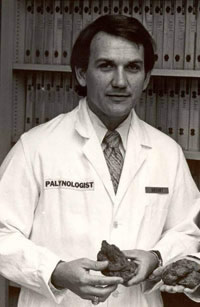
Vaughn Bryant. 1976 photo, courtesy of Glena Dean.
Vaughn Bryant was born in Dallas, but grew up in South America and Alaska. After completing a BA in geography, he earned an MA in anthropology, followed by a doctorate degree in botany, all from the University of Texas at Austin. His dissertation focused on the use of fossil pollen and plant macrofossils to reconstruct the paleoenvironment of Texas during the past 30,000 years, as well as the prehistoric diets of Native Americans over the last 10,000 years. Vaughn was the first anthropologist at Texas A&M University and spent two decades as department head, creating a doctoral-granting anthropology program. Currently, he is the director of the Texas A&M Palynology Laboratory and spends most of his time teaching, working with graduate students, and pursuing pollen studies of archeological sites and working with law enforcement personnel in the emerging field of forensic palynology. 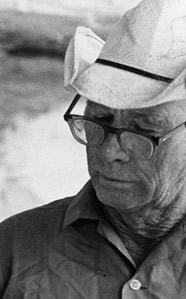 Carrol M. Hinds. TAMU Anthropology archives.
The Hinds Cave project would not have happened had it not been for the assistance provided by Fred Speck and Alfred H. Walker. Fred, now a dermatologist in Kerrville, was a student at Texas A&M University in 1973 and brought the site to the attention of Shafer. The late Mr. Walker and his wife Nell introduced Shafer and Bryant to Carrol M. Hinds, the ranch owner. The late Mr. Hinds deserves special thanks for opening his ranch to the Texas A&M research team and enlightening us with many colorful stores about the ranching history in the area. 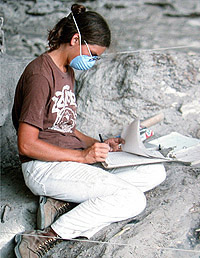
Glenna Williams-Dean, 1975.. TAMU Anthropology archives.
Graduate field assistants and volunteers carried out much of the field work. Glenna Dean (then Williams-Dean) was a graduate field assistant for two seasons. Glenna supervised the excavations in Area B and used the coprolite data for her dissertation research. She is now the State Archeologist of New Mexico. J. Phil Dering was a graduate field assistant in Area A and used the data from that excavation for his M.A. thesis at Texas A&M. Phil is now the archeologist for the Texas Forest Service and a consulting archeobotanist and archeologist in Comstock, Texas. Edward Baxter was a field assistant for two seasons and is currently a free-lance archeologist living in College Station. 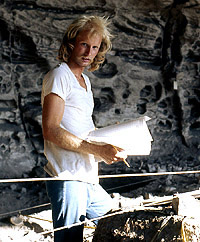
Phil Dering, 1975. TAMU Anthropology archives.
Among the many individuals who spent volunteer time working at Hinds Cave include Darrell Creel, John Ippolito, Karen Clary, Tom Sterns, and Karen Smith. D. Bruce Dickson directed a summer archeological field school on the ranch in 1976. Funding for the Hinds Cave Project came from several sources. The first little grant was for $110 from the Winship Foundation of Corpus Christi. This provided funding for the first visit to the Cave by Harry, Vaughn, and Phil in 1974. Information provided by this exploratory trip was used to prepare a grant proposal to the National Geographic Society, who provided $5,000 that funded the entire 1975 field season. The very successful first season gave us the information we needed to go to the National Science Foundation for additional funding. The National Science Foundation award of $74,000 funded the 1976 season and one year of graduate student research and analysis. Additional funding was provided by the Department of Anthropology and College of Liberal Arts at Texas A&M that helped cover salaries for faculty and staff.
Print SourcesShafer, Harry J,, editor For other printed references and links to the archeology and art of the area, see Lower Pecos Canyonlands Credits and Sources. Hinds Cave BibligraphyBelow are all of the major Hinds Cave publications, theses, and dissertations, as well as some of the articles and book chapters that focus on data from Hinds Cave. Andrews, Rhonda L. and James M. Adovasio 1986 Minor League? A Reply to Glenna Williams-Dean. North American Archaeologist 7(4): 355-363. Bement, Leland C. and Solveig A. Turpin Collins, Michael B. Danielson, Dennis R. and Karl J. Reinhard Dean, Glenna (see also Williams-Dean) Dering, J. Philip 1999 Earth Oven Plant Processing in Archaic Period Economies: An Example from a Semi-Arid Savannah in South-Central North America. American Antiquity 64(4): 659-674. Edwards, Sherrian K. Lord, Kenneth J. Poinar, H., M. Kuch, K. Sobolik, I. Barnes, A Stankiewicz, T. Kuder, W. Spaulding, V. Bryant, A. Cooper, & S. Paabo Reinhard, Karl J. Karl J. Reinhard, Sergio M. Chaves, John G. Jones, and Alena M. Iñiguez Riley, Timothy E. Saunders, Joe W. 1992 Plant and Animal Procurement Sites in the Lower Pecos Region, Texas. Journal of Field Archaeology 19(3): 335-350. Shafer, Harry J. Shafer, Harry J. and Vaughn M. Bryant, Jr. 1977 Archeological and Botanical Studies at Hinds Cave, Val Verde County, Texas. Annual Report to the National Science Foundation, Texas A&M University, Anthropological Laboratory, Special Series 1. Shafer, Harry J. and Richard G. Holloway Shafer, Harry J. and Fred Speck, Jr. Sobolik, Kristin D. Steelman, Karen L., Marvin W. Rowe, Solveig A. Turpin, Tom Guilderson, and Laura Nightengale Stock, Janet. A. Tito, Raul Y., Samuel L. Belknap III, Kristin D. Sobolik, Robert C. Ingraham, Lauren M. Cleeland, and Cecil M. Lewis Williams-Dean, Glenna (see also Dean) 1984 Putting Dinner on the Table in the Texas Archaic. Chihuahuan Desert Discovery 15:10-13. 1986 Book Review of Andrews and Adovasio (1980). In North American Archaeologist 7(2):176-182. |